Smart Glasses Holy Grail?
 Saturday, March 20, 2021 at 1:55PM
Saturday, March 20, 2021 at 1:55PM  The march toward a consumer viable smart glasses has always been more like a slow waltz… or worse—two steps forward, one step back. Events of recent weeks have brought us to a significant moment… but are we there yet? I have in the past referred to achieving a waveguide inside a prescription lens as a “Holy Grail” milestone, in the pursuit of mass consumer viable smart glasses.
The march toward a consumer viable smart glasses has always been more like a slow waltz… or worse—two steps forward, one step back. Events of recent weeks have brought us to a significant moment… but are we there yet? I have in the past referred to achieving a waveguide inside a prescription lens as a “Holy Grail” milestone, in the pursuit of mass consumer viable smart glasses.
 In smart glasses, the competition for Google is not Apple; the competition for Apple smart glasses is not Facebook; nor is Amazon, Microsoft’s competition. The competition for mass consumer adopted smart glasses is the entire tech industry versus conventional glasses. Period. That will define success in the market.
In smart glasses, the competition for Google is not Apple; the competition for Apple smart glasses is not Facebook; nor is Amazon, Microsoft’s competition. The competition for mass consumer adopted smart glasses is the entire tech industry versus conventional glasses. Period. That will define success in the market.
Mass consumer smart glasses adoption will not occur until the choice is between a new pair of smart glasses, and a wearer’s existing conventional eye-frames (or sunglasses)… and when making that choice, they choose the smart glasses. Another test is: if the electrical charge is dead, will the user continue wearing them, unpowered? In other words: Do they hold up as functional eye-frames, even when unpowered (not to mention as a fashionably stylish accessory)? When—to a majority of those who wear eyewear—the answer to that question is “yes,” smart glasses will have arrived.
Are we there yet?
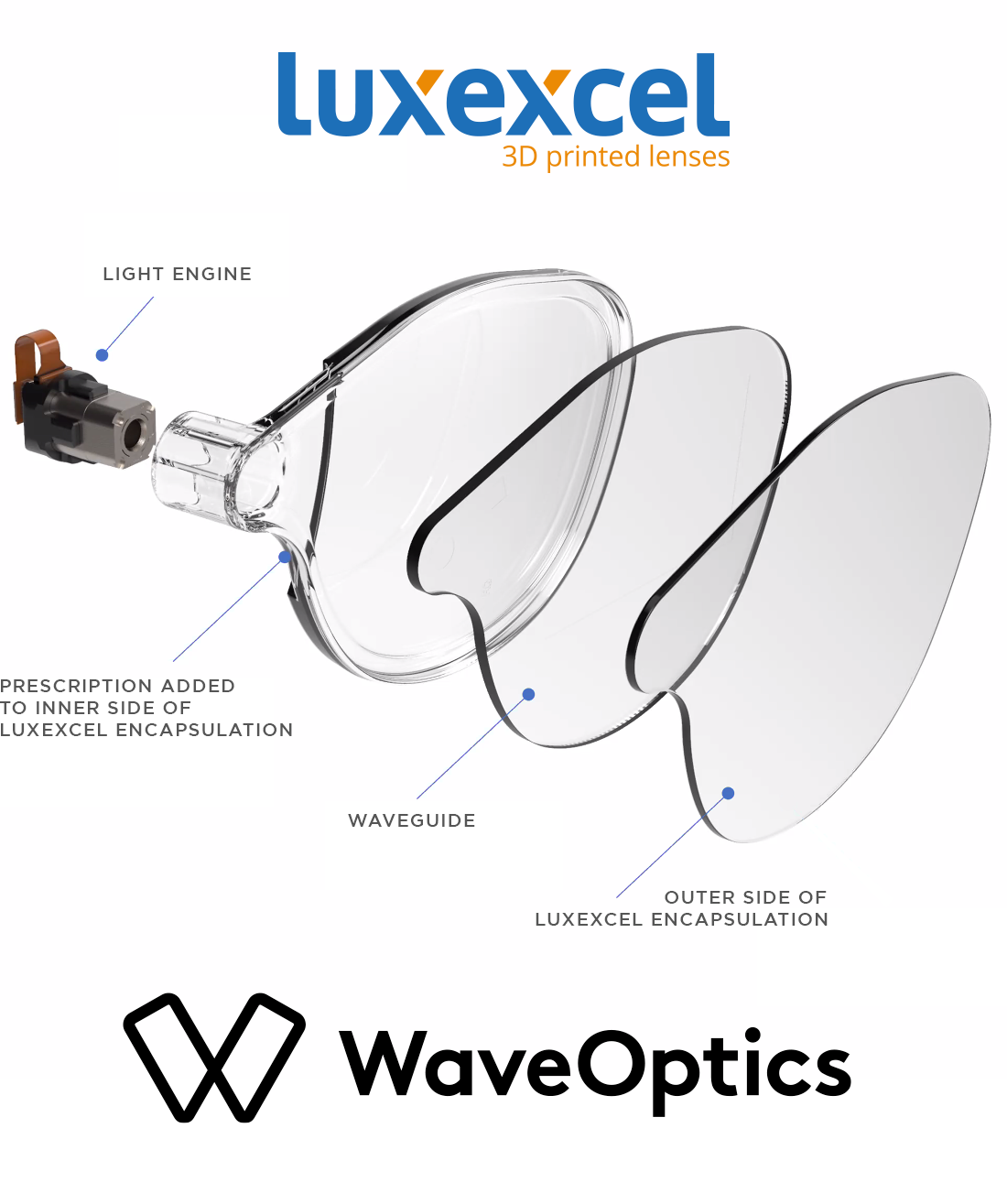
While Luxexcel’s pursuit of a waveguide within a prescription lens was known (I took a meeting with their team in January of last year to discuss their progress on this front), others had also been pursuing this goal. The same month, the now acquired (and dissolved) NORTH, then maker of Focals, held private private previews of a waveguide within a prescription lens during CES (they had no booth, and no public preview was given). The year prior, in February 2019, I broke the story of NORTH’s prescription lens waveguide patent, as a contributing writer at UploadVR… and here we are two years later. So I’ve approached celebration with caution.

On December 4, 2020, Luxexcel business strategist, Guido Groet announced the news to the world that they had successfully executed a waveguide within a prescription lens; on February 9th of this year, waveguide display partner WaveOptics revealed their module; and last Wednesday, via SPIE, the two companies held a webinar to reveal more details… if partially. It is from the deck at this presentation that the above image is derived (The full presentation is now available online. I encourage readers to watch it).
To provide the reader context, I’ve included two prior video from the partner, briefly explaining the technology they bring to the partnership. The first is Luxexcel’s 3D printed lenses. This is a time-lapse video:
The full printing process for the prescription waveguide is said to take about 20 minutes, in bulk (number of lenses simultaneously dependent on the size of the printer bed). Last January Luxexcel’s team shared with me the hurdles ahead for their year—scaling manufacturing involved building lens printers with larger beds, and building more printers. Their pain point involved ramping up the supply chain for some of their printer parts, a problem they were focused on contemporaneous to their waveguide within a lens innovation.
Fast forward to the end of last year, and in tandem with their December prescription waveguide announcement, they also hit a volume manufacturing milestone of 50,000 lenses printed. While this is a small number for a mass market device—by comparison, Apple sold 15 million iPhones in a single quarter last year (and a stereoscopic pair of smart glasses would require two lenses)—Luxexcel had nevertheless demonstrated their ability to deliver on multiple vectors: they scaled their production (presumably resolving some of their supply chain concerns), they secured an A-List collaboration partner (WaveOptics), and they delivered the elusive prescription waveguide.
Take a moment to watch Salim Valera, Chief Scientist of WaveOptics describe the optics behind their famously large eye-box, waveguide:
But there’s more to this story.
There is at least one more significant player in this partnership. The module consists of three primary components: a 3D printed prescription lens, waveguide optics, and a display projector. This is where the story got more interesting.
On February 5th of last year, WaveOptics and MicroLED developer Plessey announced a partnership to develop a display projector. Eight weeks later—first scooped by Alex Heath at The Information—it was revealed that Plessey had entered into a partnership with Facebook. Amidst rumors that Apple had made an acquisition offer, but Plessey was reluctant to sell, so Facebook countered with a long-term contract to buy all Plessey’s MicroLED inventory, while otherwise letting them remain independent.
The Facebook announcement had come not just on the heels of the WaveOptics partnership, but also demonstrated a breakthrough backplane technology: GaN-on-Si (Gallium Nitride on Silicon), a development that—if living up to its promise—could simplify and miniaturize the optics on light engine projectors. The light from a standard MicroLED panel (or LBS projector and other light engines, for that matter) must pass through a collimation lens. That is to say, a lens that tidies up the light into a unidirectional projection, to flow properly into the waveguide’s input coupler (input grating). In theory, employing this GaN-on-Si backplane might allow for the elimination of the collimation optics all together, allowing for a significantly smaller form factor, not to mention a simpler module with fewer components, and less loss-of-light, overall. The fact that Plessey coupled this with announcement of a 1080p MicroLED microdisplay placed them at the forefront of competing light engine technologies.
Alas, nothing in optics is this simple…
Let’s go back and have a look at that prescription lens waveguide again. More explicitly, what does that projector (with the “unknown” partner) look like anyway?
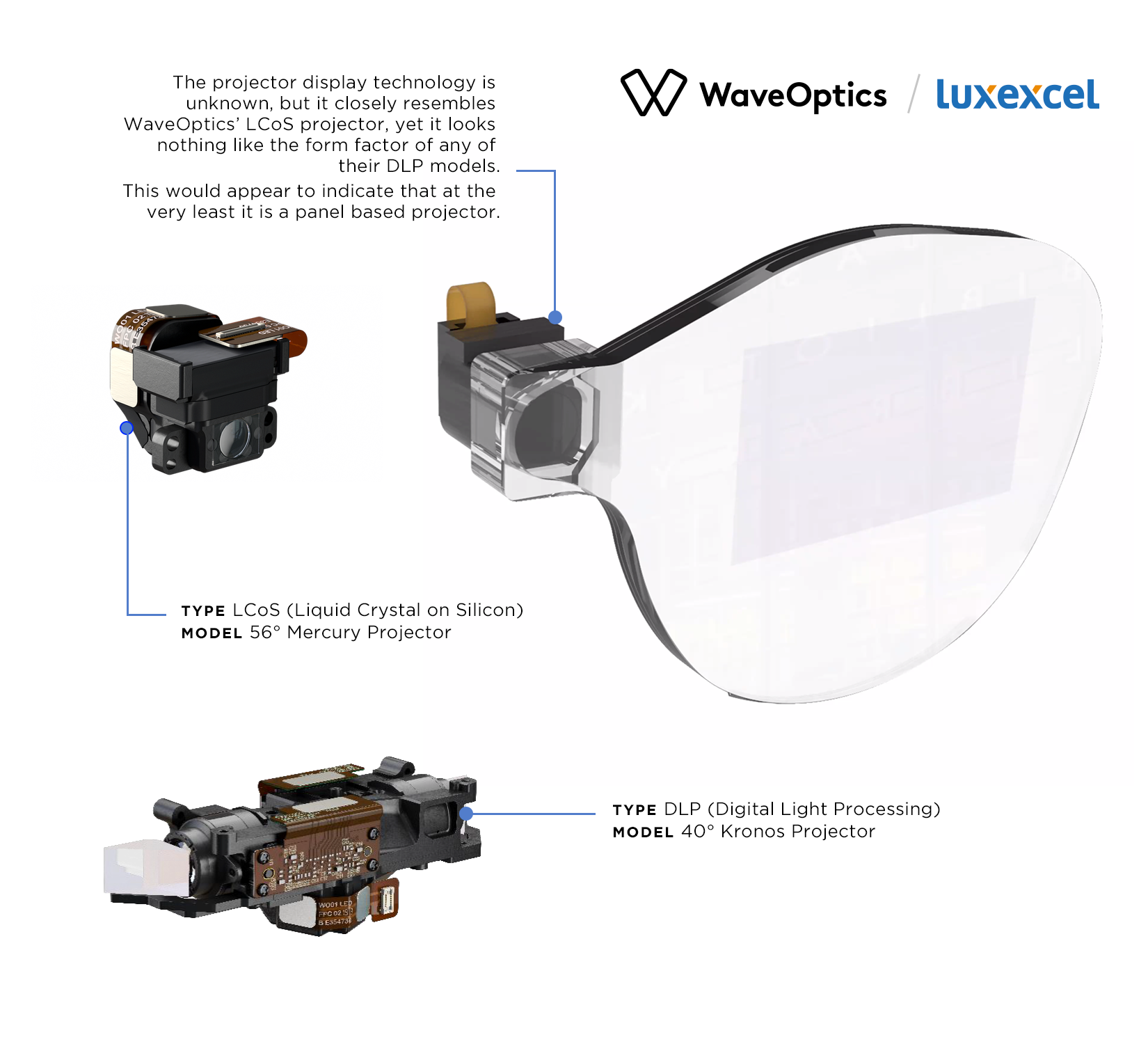
In their presentation we also learned that the module is only available in monochrome green. This tells us a lot. See, the MicroLED microdisplay industry is having a devil of a time creating a full color panel in the diode size required for a MicroLED, at a density needed in a microdisplay.
Red? Yep!
Green? Yep!
Blue? Yep!
Full color? Not there yet.
Specifically, Plessey has worked in collaboration with Nanoco to get their diodes under 4 µm in size. They can now make a 1080p HD microdisplay panel at 0.26”… but not in full color.
There are others in the MicroLED microdisplay space—significantly, LuxVue and TSMC. The former was acquired by Apple (and also has some GaN-on-Si, IP), and TSMC is the largest independent semiconductor foundry in the world and a leading Apple supplier. Apple recently invested heavily in building a MicroLED research center, adjacent to TSMC’s campus in Taiwan. More importantly, there are others with GaN-on-Si backplane technology. Plessey’s GaN-on-Si IP came through the acquisition of CamGan, a University of Cambridge spinout. They then collaborated with Jasper Display to take CamGen’s technology into scalable production. Further, ALLOS and Veeco co-developed GaN-on-Si manufacturing for MicroLED manufacturing, and have subsequently licensed the technology to Epistar, and to OSRAM (the later, recently acquired by AMS, supplier of Apple’s iPhone face scanning sensor).
Plessey has a lead in the industry… for now.
But this still doesn’t answer our question as to whether WaveOptics’ collaboration with Plessey is still active? Or did it get killed mere weeks after announced, perhaps as a result of the Facebook deal? We’ll get back to that in a moment.
We’re going to detour for a moment, and have a look at another team mentioned above, that had also been working on placing a waveguide into a prescription lens.

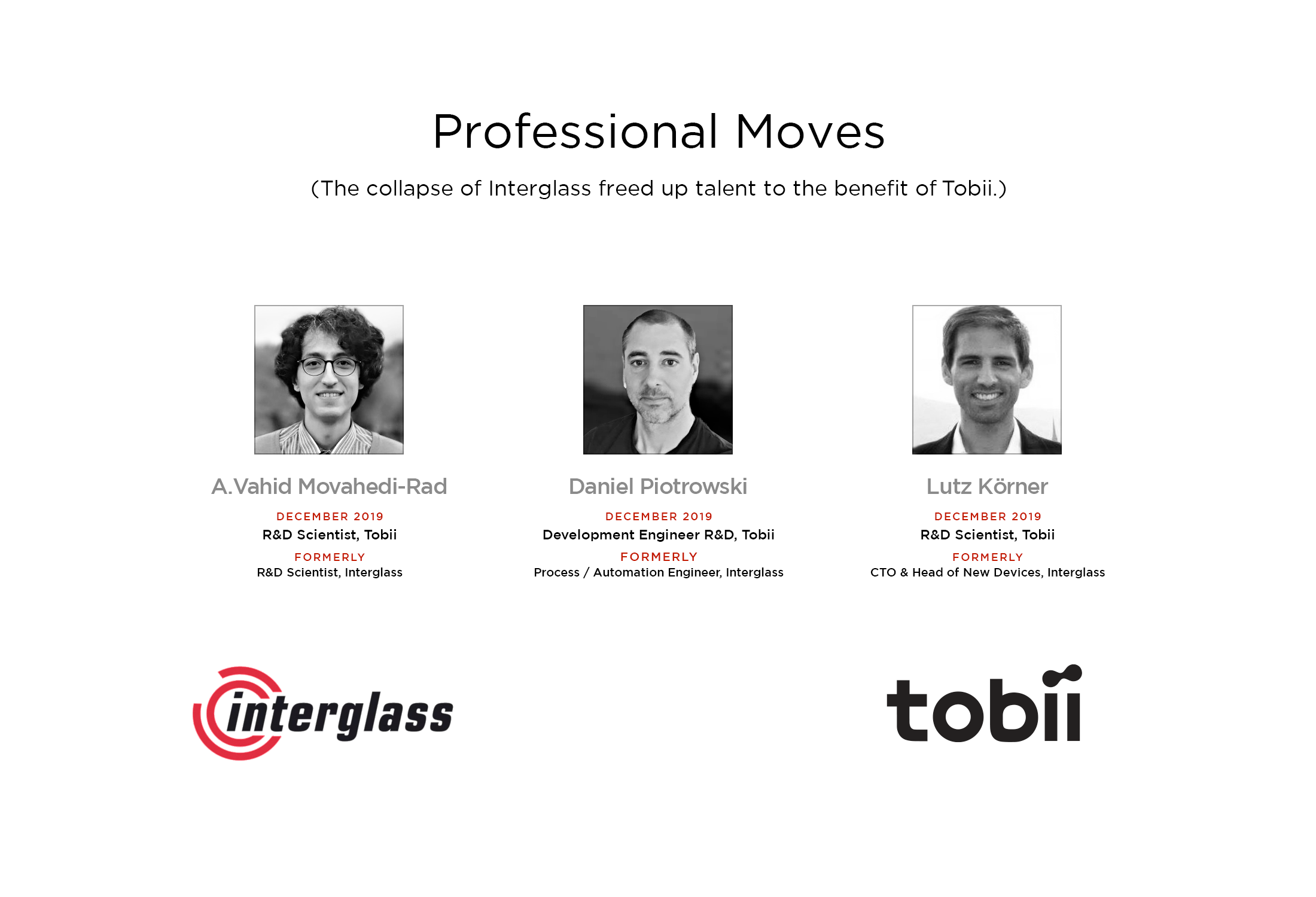
The team that Tobii poached from Interglass is significant because they were working towards a prescription lens waveguide at their prior employer. Interglass is (was?) an interesting company. They came out of École Polytechnique Fédérale de Lausanne, of Switzerland, together with a cohort of optics companies that included Lemoptix and Compsyt Light Labs. These two peers were snatched up by Intel, but for reasons unknown, Interglass was passed up. Odd because the three companies’ technologies worked as a system: Compsyt Light Labs made a color laser projector; Lemoptix made an electromechanical MEMs unit that reflected the laser into a combiner; and Interglass made a robotic resin lens manufacturing system that—among other things—embedded the optical elements of the combiner into a prescription lens.
When Intel shut down their wearable technology unit (mere weeks after releasing Vaunt), they eventually sold their IP portfolio—the crown jewel being the Lemoptix and Compsyt Light Labs patents—to NORTH (within whom Intel was already a lead investor). However Interglass, who did pitch for NORTH’s combiner business, lost out as supplier to Covestro (formerly Bayer MaterialScience). Interglass, whom I interviewed for the same article that revealed NORTH’s prescription waveguide patent, was working towards this same goal. Alas, Interglass’ team was poached en masse by Tobii, and at some point in the last few months, Interglass’ website was shut down.
Tobii’s work, while not specific to the display, is still quite significant. They’ve moved their entire eye-tracking sensor system into a lens. This is important as it shows the complex systems required for immersive AR, beyond the display itself are keeping pace, both with their miniaturization, and their incorporation into the lens.
Now let’s get back to MicroLED light engines…


Prior to Plessey’s Facebook deal, they had entered into a supplier relationship with Vuzix. There was much speculation around whether this prior supplier contract would be honored, and grandfathered into the Plessey / Facebook exclusivity deal.
In January Vuzix confirmed that they had entered into a new supplier, and light module co-development relationship with Jade Bird. Prior to this, last September Vuzix released a video that revealed both a monochrome, and a full color module. The design of the color module was revealing:
Note that the color module above is broken in to three separate projector, combined it one modular unit. In order for this to work, a special three layer waveguide would be needed, with a separate input coupler for each color. This would prove a troubling solution if one hoped to stagger waveguides with independent input couplers—a method several, including Apple and DigiLens have pursuing to expand the field of view. Instead, extra input couplers would simply be used to composite RGB input from three monochrome MicroLEDs.

The prior video was from September, but by January Vuzix had announced the Jade Bird Display partnership, and had a better solution. As far back as at least 2018, Jade Bird had proposed using a dichroic x-cube splitter / combiner, to composite RBG, from separate MicroLED panels.
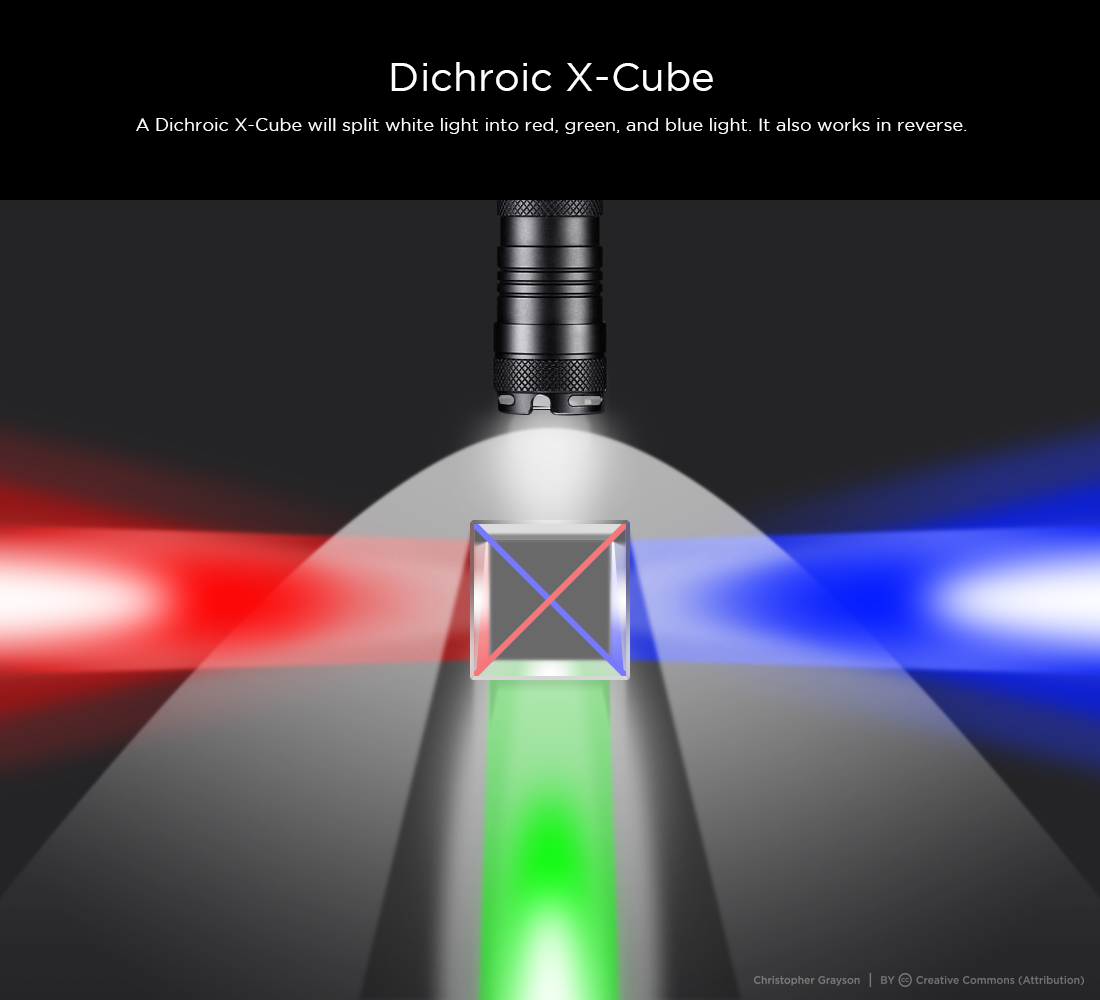
In the video excerpt below Vuzix revealed the design of two new light modules, one monochrome green, the second a dichroic x-cube compositing RGB projector (A further explanation of the x-cube used for composite is provided in a diagram beneath.).

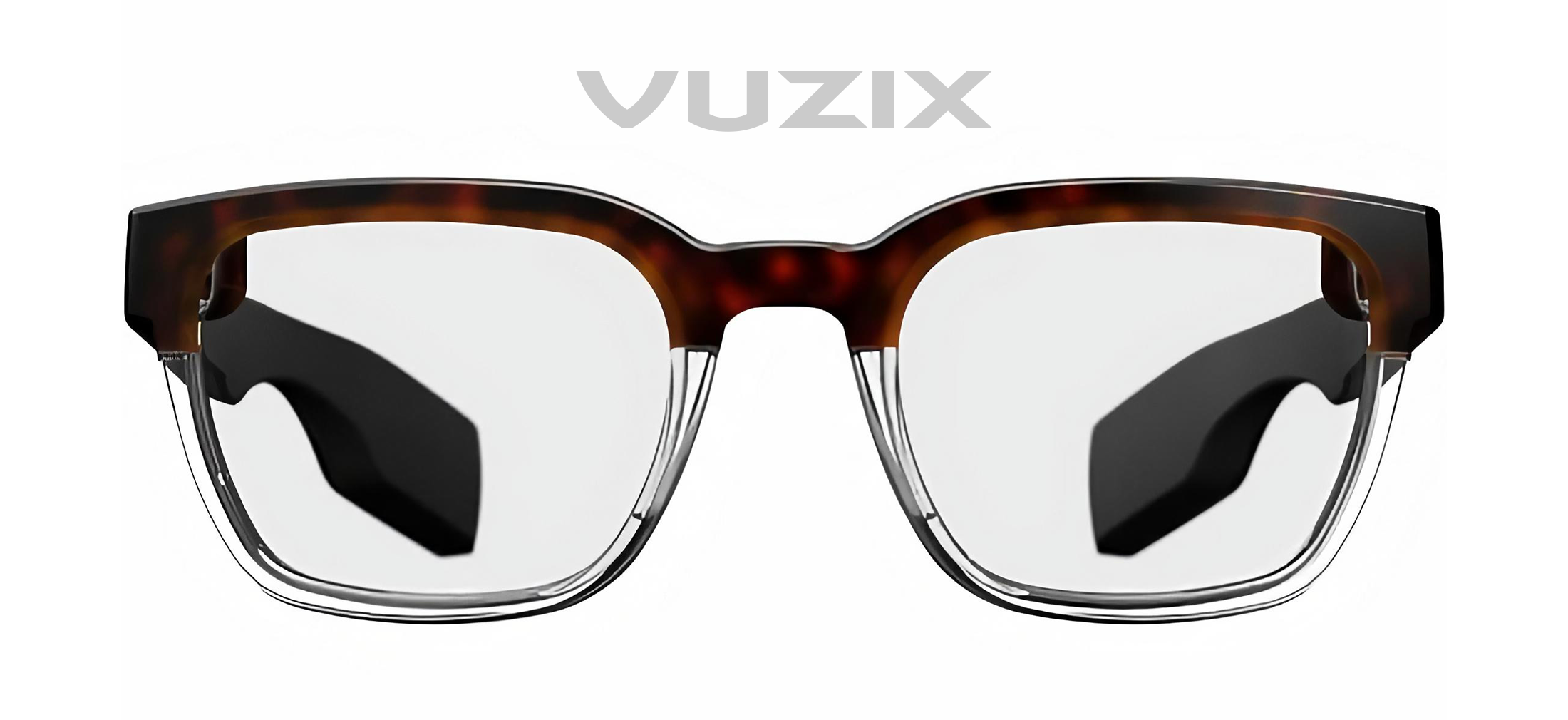
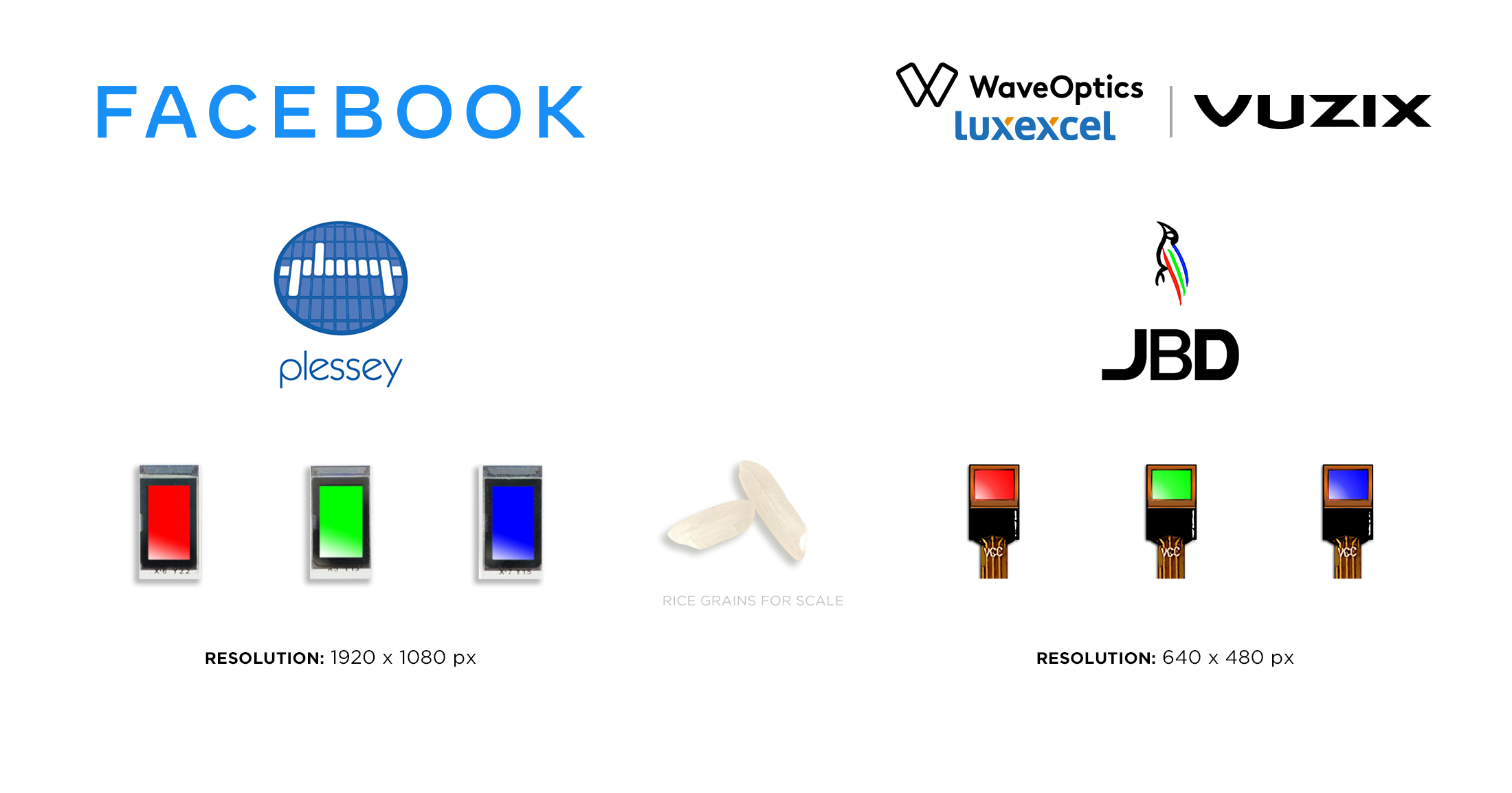
Phil Greenhalgh, WaveOptics’ CTO confirmed that the Plessey collaboration was indeed also blown up by the Facebook deal, much as Plessey’s supplier relationship with Vuzix. Also like Vuzix, WaveOptics is now working with Jade Bird. In the short term, the winner in the Plessey / Facebook contract has proven to be Jade Bird (who also recently entered into a development partnership with Kopin).
Leon Baruah has unique insight given that he was Senior Sales Manager for Plessey up until the date they entered their arrangement with Facebook (not much to sell, when you have an exclusive long-term buyer). The following month he joined Jade Bird as Director of Marketing and Sales, and it appears Plessey’s non-Facebook clients followed. Leon could not speak about any partnerships except those already in the public domain—until this article, that was only Vuzix and Kopin. Given Plessey’s exclusivity with Facebook, their former clients had few choices—as Greenhalgh noted, the MicroLED microdisplay market is “a limited option space.”
Explaining Jade Bird & Plessey similarities and difference, Baruah said they both “have concentrated the efforts on µLED microdisplays and the processes for both companies are more suitable for microdisplays, i.e. <1.0” diagonal but smaller the better. Both companies utilise monolithic hybridisation method for wafer level production of microdisplays. This is where the similarities stop as the processes are vastly different.”
“Both JBD & Plessey have unique strengths in the manufacturing processes,” Baruah continued, “but JBD started with µLED displays in 2015 whereas Plessey started looking at µLED displays in 2018 so JBD had a head start in this respect,” emphasizing the head start of his new employer.
Baruah suggests “in the mid-long term, full colour µLED microdisplays will be launched,” but suggested the dichroic x-cube “approach is a viable solution and with our technology we can still end up with a projector that is really small ~1.35cc.” Greenhalgh suggested from his experience, “three video channel x-cube systems are fraught with image quality, alignment, manufacturing, electrical drive and size considerations,” but on Jade Bird’s efforts in this area caveated, “never say never.”
Greenhalgh expects we are “2-3 years from seeing a full HD panel with energy confinement, constant current drive backplane that is small enough to be used in [an] AR light engine.” This is inline with both projections for expected Apple smart glasses, as well as with remarks made recently by Mark Zuckerberg on The Information’s 411 podcast with Alex Heath.
Getting a waveguide display into a prescription lens is truly a milestone. Eventually the industry will get to an HD resolution MicroLED color microdisplay, and soon after perhaps three will drive a multilayered waveguide with an expanded field of view. For now, the x-cube composited color module is too large to consider multiple units in a consumer design (it’s honestly questionably viable in a consumer form factor, with only one projector), and some are skeptical of the quality it can deliver.
But this past week the industry took a major step. Getting a waveguide into a prescription lens has been a Holy Grail pursuit for a decade, and Luxexcel and their WaveOptics partner have delivered.
You can learn more about their collaboration by attending SPIE’s AR/VR/MR event next week, where Luxexcel’s Chief Strategic Officer, Guido Groet will be speaking on Monday March 29th, 10:00 AM - 10:25 AM PT.
Plessey was contacted for this article and declined to comment. Here, enjoy a demonstration of their breakthrough 1080p HD, MicroLED microdisplay in monochrome green:

Christopher Grayson is a marketer, market analyst, writer, and former advertising creative director. He is available for consulting projects, editorial, and creative direction (He is also available for hire.).
Christopher Grayson has also been a contributing writer to UploadVR, and to 20/20 Magazine. Readers can stay abreast of smartglasses, near-eye optics, and the fashion eye-frames industry—by following Chris Grayson on Twitter.
